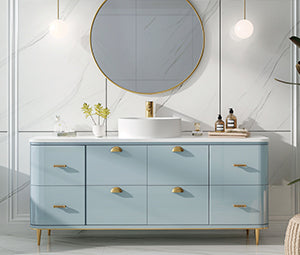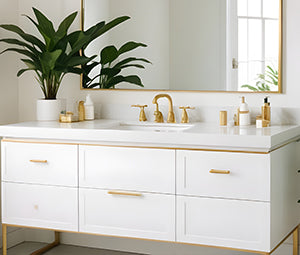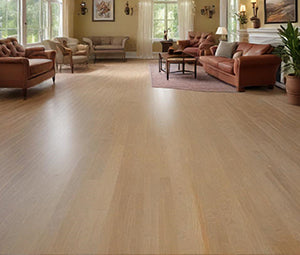How To Choose And Install Hardwood Flooring
Of all the flooring options, hardwood is arguably the most coveted among homeowners. Sleek, durable and breathable, hardwood flooring makes a statement in any room. Unfortunately, one peek at the costs of professional installation might make you push hardwood flooring to the bottom of your home improvement wish list – but it doesn’t have to.
Solid Hardwood
As the name implies, solid hardwood flooring is made of pure, solid wood. Each board is a single piece of wood that is about three quarters of an inch thick. “Solid hardwood floors are very durable,” says Tom Ory, owner of Enterprise Wood Products.
“Solid hardwood pricing varies depending on species and finishes, but when you factor in their durability, they are definitely a great purchase,” says Ory. “It is also known that having solid hardwood flooring in your home will increase its value, making it an investment as well.”
With good maintenance, solid hardwood can last for over 100 years, and should be sanded and refinished about once every ten years.
Engineered Hardwood
Engineered hardwood flooring are made up of layered wood and plywood. The top and bottom of the boards are thin layers of solid wood, but between them lies a high-quality plywood base.
Engineered wood is typically less expensive than solid hardwood. Some premium engineered flooring can have added durability finishes or higher quality core layers, which can cost more than lower-end solid hardwood options.
Difference Between Solid and Engineered Hardwood Flooring
According to Kristin Warner of Floor Critics, “The main difference between engineered hardwood floors and solid hardwood floors is their construction. Additionally, solid hardwood floors are greatly affected by temperature and humidity. In the dry winter, hardwood floors will shrink, and in summer they will expand. If humidity is an issue where you live, engineered hardwood might be the better option as it doesn’t expand and contract nearly as much. Also, engineered wood is more resistant to spills and mold from moisture creeping under the planks.”

Selecting Style Options
- Color
A hardwood floor’s color comes from any stains and finishes that have been applied, as well as the natural hues of its wood species. Some wood species have greater natural variations in color on individual planks and from plank to plank, giving the wood unique character. Others have less variation for a more uniform look.
- Wood Species
The type of wood your hardwood flooring is made from can have a huge influence on the overall style. For example, Oak hardwood has an eye-catching grain with a lot of variation, while Maple graining is fine and straight. Exotic species often have bold, statement-making grain patterns. Species also differ in how much natural character they convey. Some have more filled knots, filled splits and large mineral streaks, which can feel more casual than a floor with minimal character.
- Surface Treatment and Texture
Many collections offer textures, finishes and surface treatments that allow the floors to take on different looks. Weathered, rustic and reclaimed wood styles can appear traditional or in line with modern trends, depending on how the rest of the room is styled.
- Width
Board or plank width plays an important role in helping you achieve your design vision. Narrow strips are less than 3″ and look more traditional, and they can make a smaller room look more spacious. Planks are 3″ or wider. Anything 5″ or wider is considered a wide-width plank. Wide-width planks continue to be a popular style choice for the sophistication and feeling of openness they create. There are even collections that incorporate mixed-width boards, creating a vintage look that alternates between three board sizes.
- Edge Style
Collections vary in how the edges and ends of the boards are finished. These subtle differences can affect the overall look.
What To Consider
Even the toughest hardwood floors can be subject to scuffs and scratches if you’re not careful. If you have a high-traffic home with kids and/or pets you’ll want to look out for flooring styles with greater durability. These are some different factors that can affect how resistant to scratches, dents and water your flooring is.
- Wood species
Every type of hardwood has a hardwood hardness rating . The harder the wood, the better it can withstand dents and dings. Hickory, Oak and Maple are three of the hardest Bruce offers.
- Protective finish
Every hardwood flooring product has a protective finish, and we offer different levels of protection that can impact how well the floors resist scratches and stains. The highest level, Our Lifetime Finish, provides superior protection and is backed by a lifetime warranty.
- Gloss level and floor texture
Hardwood products that have a matte finish and/or texture (such as distressed hand-scraped styles) are better at hiding everyday wear than smooth, high-gloss floors.
- Water resistance
Hardwood is not generally known for its water-resistant qualities, but some collections are more spill-friendly than others. Our Hydropel 36-hour water-resistant flooring is engineered to perform beautifully in rooms where hardwood is not usually an option.
How To Install Hardwood Flooring
One of the major ways to save money on hardwood floors is to install them yourself. You'll save on labor and spend your money on the materials. Suppliers of hardwoods can provide instructions for installation. If you need professional help with installation, make sure to contact us at (972) 241-4444 to speak with our installation manager Mack.








